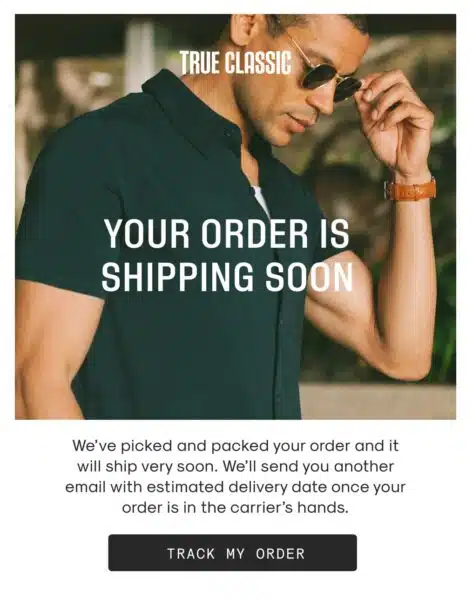How True Classic uses post-purchase experiences to increase revenue
The company increased customer satisfaction with the aid of a tool by parcelLab that provides accurate shipping and delivery updates.
Consumers inundated with marketing messages are receptive when the message is about a high-priority item they’ve purchased. U.S. apparel brand True Classic has leveraged this to improve customer satisfaction and increase revenue.
The company discovered this when they began sending messages to customers post-purchase with accurate shipping and delivery details. Not only are the messages welcomed by customers as a key part of the customer service experience, but they drive revenue by encouraging repeat purchases. It’s all part of a virtuous cycle that begins with better, more accurate communications.
Dig deeper: Driving growth through data: Optimizing the retention stage
Shipping around the world
Launched in 2019, True Classic grew to $100 million in revenue after only two years. They started with a classic men’s t-shirt and eventually expanded to pants, jeans, polos and activewear. In 2022, the brand opened its first five retail stores. True Classic customers can order from 192 countries — the company is a truly global brand.
Shipping to so many regions, however, means complicated delivery chains that are difficult to forecast.
“We were looking last year to solve a really big problem as we scaled globally, and that was how with limited resources we could address post-purchase experience,” said Breanna Moreno, True Classic’s VP of customer experience. “With international sales, we wanted to set clear expectations for when orders would arrive.”
She added, “You never want your consumer to reach out to you asking, ‘Where’s my order?’ So we were really hungry to solve for this.”
Implementing a new post-purchase experience
Last year, True Classic implemented a tool created by parcelLab, a post-purchase experience software company. It helps enterprise retailers like IKEA and Chico’s make customers’ shipping and delivery experiences transparent by tracking data from 350 carriers and using AI-powered analytics to estimate delivery times and anticipate delays.
Getting accurate delivery information spurs customers’ interest and loyalty. The parcelLab tool nearly doubled the click-through rate of a previous solution True Classic used.
“The entire experience lives on the True Classic website, which sometimes you can’t have that experience when you’re working with third-party vendors in that capacity — so that was really exciting,” Moreno said.

Delivering the right message post-purchase
ParcelLab’s technology not only provides accurate delivery estimates, it also optimizes how customers receive messages based on engagement.
For instance, a customer might prefer emails to texts. Message preferences vary according to different countries and regions, and these insights are another advantage to using a solution that covers so many international markets.
True Classic hasn’t changed the format of emails and still uses its legacy Klaviyo email platform.
“We haven’t updated the email, it’s literally verbatim our old email structure, updated with parcelLab supporting it,” said Moreno. “What that tells us internally is there’s an opportunity to make emails that much better, considering we’ve seen such significantly higher RPE (revenue per email).”
Since implementing the new solution, RPE has increased 34.8% and the in-order rate is up 22.5%. The click-through rate on emails has increased 1.87% and the open rate is up 6.55%.
With granular data on individual orders and post-purchase segments, True Classic can inform customers about weather delays and other anticipated issues around the world. ParcelLab uses AI-powered predictive analytics to make sense of the data they receive from the carriers to provide updated information to True Classic, which the brand passes on to consumers.
“ParcelLab elevates the brand’s capability to control these customers’ experiences,” said Julian Krenge, CTO and co-founder of ParcelLab. “We help them convert with a promise, and then manage satisfaction and experience.”
Commitment to the customer
According to Krenge, better customer service begins earlier in the customer journey — before the purchase, when marketers set expectations about how the post-purchase experience will go.

It’s up to the brand to look at the data and decide what promises the brand can make to customers, and which policies customers will prefer. In the case of True Classic, these promises become value propositions. For instance, estimated delivery times for items are provided when customers are on the checkout screen, before making the purchase. Additionally, customers are given 30 days after purchase to return any product (other than items marked “Final Sale”).
The company has a dedicated returns portal with designated “Happy Returns” locations where customers can easily print labels and ship returns.
Data from all these orders and packages boost confidence in the value propositions. It also helps lower risk and identify potential fraud. If there is a high volume of return requests coming from a specific customer or region, the brand can provide more steps to verify that there is an issue with the products and that it’s not a fraudster. The company can request a picture be taken of damaged items, for instance.
On the positive side, the post-purchase experience is a time of high engagement for the customer, often overlooked by marketers.
“Customers are never more engaged than after they make a purchase,” said Krenge. “There’s this domain of when you’re delivering the service to the customer and it’s very under-utilized. Retailers really don’t have this and it’s the highest attention period.”
Dig deeper: How TD Bank connects customer experience with sound
Related stories
New on MarTech